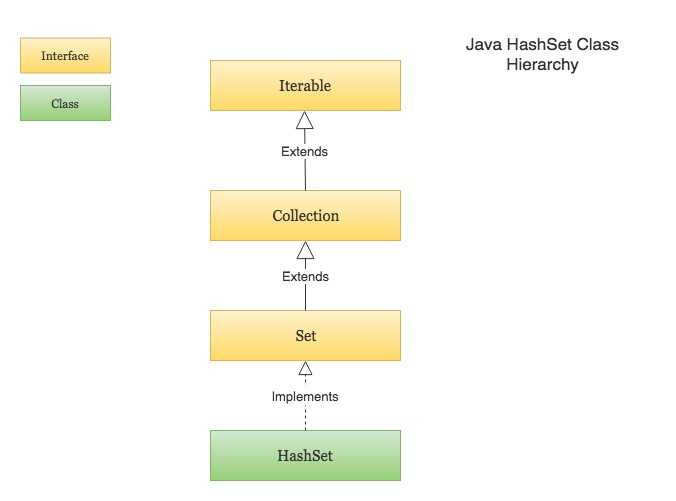Java HashSet class is a member of Java collections framework. It implements the Set interface. HashSets are used to store a collection of unique elements.
Following are few key points to note about HashSet in Java -
HashSet cannot contain duplicate values.
HashSet allows
nullvalue.HashSet is an unordered collection. It does not maintain the order in which the elements are inserted.
HashSet internally uses a HashMap to store its elements.
HashSet is not thread-safe. If multiple threads try to modify a HashSet at the same time, then the final outcome is not-deterministic. You must explicitly synchronize concurrent access to a HashSet in a multi-threaded environment.
Creating a HashSet and adding new elements to it.
The example below shows how to create a HashSet using the HashSet() constructor, and add new elements to it using the add() method.
import java.util.HashSet;
import java.util.Set;
public class CreateHashSetExample {
public static void main(String[] args) {
// Creating a HashSet
Set<String> daysOfWeek = new HashSet<>();
// Adding new elements to the HashSet
daysOfWeek.add("Monday");
daysOfWeek.add("Tuesday");
daysOfWeek.add("Wednesday");
daysOfWeek.add("Thursday");
daysOfWeek.add("Friday");
daysOfWeek.add("Saturday");
daysOfWeek.add("Sunday");
// Adding duplicate elements will be ignored
daysOfWeek.add("Monday");
System.out.println(daysOfWeek);
}
}# Output
[Monday, Thursday, Friday, Sunday, Wednesday, Tuesday, Saturday]Creating a HashSet from another collection
The following example shows how to
- Create a HashSet from another collection using the HashSet(Collection c) constructor.
- Add all the elements from a collection to the HashSet using the addAll() method.
import java.util.ArrayList;
import java.util.HashSet;
import java.util.List;
import java.util.Set;
public class CreateHashSetFromCollectionExample {
public static void main(String[] args) {
List<Integer> numbersDivisibleBy5 = new ArrayList<>();
numbersDivisibleBy5.add(5);
numbersDivisibleBy5.add(10);
numbersDivisibleBy5.add(15);
numbersDivisibleBy5.add(20);
numbersDivisibleBy5.add(25);
List<Integer> numbersDivisibleBy3 = new ArrayList<>();
numbersDivisibleBy3.add(3);
numbersDivisibleBy3.add(6);
numbersDivisibleBy3.add(9);
numbersDivisibleBy3.add(12);
numbersDivisibleBy3.add(15);
// Creating a HashSet from another collection (ArrayList)
Set<Integer> numbersDivisibleBy5Or3 = new HashSet<>(numbersDivisibleBy5);
// Adding all the elements from an existing collection to a HashSet
numbersDivisibleBy5Or3.addAll(numbersDivisibleBy3);
System.out.println(numbersDivisibleBy5Or3);
}
}# Output
[3, 20, 5, 6, 25, 9, 10, 12, 15]HashSet simple operations
- Check if a HashSet is empty | isEmpty()
- Find the number of elements in the HashSet | size()
- Check if an element exists in the HashSet | contains()
import java.util.HashSet;
import java.util.Set;
public class HashSetSimpleOperationsExample {
public static void main(String[] args) {
Set<String> popularCities = new HashSet<>();
// Check if a HashSet is empty
System.out.println("Is popularCities set empty? : " + popularCities.isEmpty());
popularCities.add("London");
popularCities.add("New York");
popularCities.add("Paris");
popularCities.add("Dubai");
// Find the size of a HashSet
System.out.println("Number of cities in the HashSet " + popularCities.size());
// Check if the HashSet contains an element
String cityName = "Paris";
if(popularCities.contains(cityName)) {
System.out.println(cityName + " is in the popular cities set.");
} else {
System.out.println(cityName + " is not in the popular cities set.");
}
}
}# Output
Is popularCities set empty? : true
Number of cities in the HashSet 4
Paris is in the popular cities set.Removing elements from a HashSet
This example shows how to:
- Remove an element from a HashSet.
- Remove all the elements that exist in a given collection from the HashSet.
- Remove all the elements that satisfy a given predicate from the HashSet.
- Clear the HashSet completely by removing all the elements.
import java.util.ArrayList;
import java.util.HashSet;
import java.util.List;
import java.util.Set;
public class HashSetRemoveExample {
public static void main(String[] args) {
Set<Integer> numbers = new HashSet<>();
numbers.add(2);
numbers.add(3);
numbers.add(4);
numbers.add(5);
numbers.add(6);
numbers.add(7);
numbers.add(8);
numbers.add(9);
numbers.add(10);
System.out.println("numbers : " + numbers);
// Remove an element from a HashSet (The remove() method returns false if the element does not exist in the HashSet)
boolean isRemoved = numbers.remove(10);
System.out.println("After remove(10) => " + numbers);
// Remove all elements belonging to a given collection from a HashSet
List<Integer> perfectSquares = new ArrayList<>();
perfectSquares.add(4);
perfectSquares.add(9);
numbers.removeAll(perfectSquares);
System.out.println("After removeAll(perfectSquares) => " + numbers);
// Remove all elements matching a given predicate
numbers.removeIf(num -> num % 2 == 0);
System.out.println("After removeIf() => " + numbers);
// Remove all elements from HashSet (clear it completely)
numbers.clear();
System.out.println("After clear() => " + numbers);
}
}# Output
numbers : [2, 3, 4, 5, 6, 7, 8, 9, 10]
After remove(10) => [2, 3, 4, 5, 6, 7, 8, 9]
After removeAll(perfectSquares) => [2, 3, 5, 6, 7, 8]
After removeIf() => [3, 5, 7]
After clear() => []Iterating over a HashSet
The following example shows different ways of iterating over a HashSet
- Iterate over a HashSet using Java 8 forEach and lambda expression.
- Iterate over a HashSet using iterator().
- Iterate over a HashSet using iterator() and Java 8 forEachRemaining() method.
- Iterate over a HashSet using simple for-each loop.
import java.util.HashSet;
import java.util.Iterator;
import java.util.Set;
public class IterateOverHashSetExample {
public static void main(String[] args) {
Set<String> programmingLanguages = new HashSet<>();
programmingLanguages.add("C");
programmingLanguages.add("C++");
programmingLanguages.add("Java");
programmingLanguages.add("Python");
programmingLanguages.add("PHP");
programmingLanguages.add("Ruby");
System.out.println("=== Iterate over a HashSet using Java 8 forEach and lambda ===");
programmingLanguages.forEach(programmingLanguage -> {
System.out.println(programmingLanguage);
});
System.out.println("=== Iterate over a HashSet using iterator() ===");
Iterator<String> programmingLanguageIterator = programmingLanguages.iterator();
while (programmingLanguageIterator.hasNext()) {
String programmingLanguage = programmingLanguageIterator.next();
System.out.println(programmingLanguage);
}
System.out.println("=== Iterate over a HashSet using iterator() and Java 8 forEachRemaining() method ===");
programmingLanguageIterator = programmingLanguages.iterator();
programmingLanguageIterator.forEachRemaining(programmingLanguage -> {
System.out.println(programmingLanguage);
});
System.out.println("=== Iterate over a HashSet using simple for-each loop ===");
for(String programmingLanguage: programmingLanguages) {
System.out.println(programmingLanguage);
}
}
}# Output
=== Iterate over a HashSet using Java 8 forEach and lambda ===
Java
C++
C
PHP
Ruby
Python
=== Iterate over a HashSet using iterator() ===
Java
C++
C
PHP
Ruby
Python
=== Iterate over a HashSet using iterator() and Java 8 forEachRemaining() method ===
Java
C++
C
PHP
Ruby
Python
=== Iterate over a HashSet using simple for-each loop ===
Java
C++
C
PHP
Ruby
PythonHashSet with User defined objects
This example shows how to create a HashSet of user defined objects.
import java.util.HashSet;
import java.util.Objects;
import java.util.Set;
class Customer {
private long id;
private String name;
public Customer(long id, String name) {
this.id = id;
this.name = name;
}
public long getId() {
return id;
}
public void setId(long id) {
this.id = id;
}
public String getName() {
return name;
}
public void setName(String name) {
this.name = name;
}
// Two customers are equal if their IDs are equal
@Override
public boolean equals(Object o) {
if (this == o) return true;
if (o == null || getClass() != o.getClass()) return false;
Customer customer = (Customer) o;
return id == customer.id;
}
@Override
public int hashCode() {
return Objects.hash(id);
}
@Override
public String toString() {
return "Customer{" +
"id=" + id +
", name='" + name + '\'' +
'}';
}
}
public class HashSetUserDefinedObjectExample {
public static void main(String[] args) {
Set<Customer> customers = new HashSet<>();
customers.add(new Customer(101, "Rajeev"));
customers.add(new Customer(102, "Sachin"));
customers.add(new Customer(103, "Chris"));
/*
HashSet will use the `equals()` & `hashCode()` implementations
of the Customer class to check for duplicates and ignore them
*/
customers.add(new Customer(101, "Rajeev"));
System.out.println(customers);
}
}# Output
[Customer{id=101, name='Rajeev'}, Customer{id=102, name='Sachin'}, Customer{id=103, name='Chris'}]Conclusion
Congratulations folks! In this article, you learned what is a HashSet, how to create a HashSet, how to add elements to a HashSet, how to remove elements from the HashSet, how to check if an element exists in a HashSet, how to iterate over a HashSet, and how to create a HashSet of user defined objects.
Thanks for reading. Have a good day!

